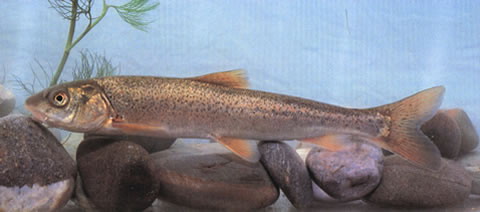| Cyprinidae (Minnows or carps), subfamily: Schizopygopsinae |
|
|
benthopelagic; freshwater |
| Asia: Zhongdian, Yunnan, China (type locality). |
|
Dorsal spines (total): 3-3; Dorsal soft rays (total): 7-8; Anal spines: 2-2; Anal soft rays: 5-5. This species possess the following characteristics: two rows of pharyngeal teeth; 3,4-4,3; one pair of barbels; sides of body above lateral line is brown with a golden shine and densely covered with black speckles, sides below lateral line are yellowish and densely covered with
black speckles, the abdomen is silver (Ref. 89909). |
| Juveniles are found in the littoral zone of the lakes and streams, while the adults inhabit the
middle and lower water layers of the lakes. Individuals return from the lake to streams to spawn in June; parental fishes spawn several times from July to September every year. The males dig pits with their anal fin rays and lay the eggs in the pit. Threatened by habitat degradation, water pollution, over-exploitation and invasion of exotic species (most notably, Micropercops swinhonis) (Ref. 89909). |
|
Endangered (EN); Date assessed: 04 November 2022 (B1ab(iii,v)) Ref. (130435)
|
| harmless |
|
Type locality: Zhongdian, Yunnan (Ref. 33021). Changjiang (Yangtse) river (Ref. 41093). Endemic to Zhongdian Plateau of Jinsha River drainage including Lake Bita, Lake Napa, Lake Shudu, Nayahe River, Xiaozhongdian
River and Gezan River (Ref. 89909). Also Ref. 33800.
Threatened by habitat degradation, water pollution, over-exploitation and invasion of exotic species (most notably, Micropercops swinhonis).
Conservation actions: Lake Bita and the primary forest around the lake have been well protected since 1984 by establishing Bitahai Provincial Natural
Reserve. A population status monitoring was also started in 2007 in Lake Bita and Lake Shudu under collaboration of Kunming Institute of Zoology, Chinese Academy of Science and Bitahai Natural Reserve. In August 2008, an artificial breeding experiment of this fish was successfully implemented.
Conservation recommendations: A formal breeding project, monitoring, and prohibition of introduction/re-introduction of alien species are necessary.
Status of threat: Endangered according to China Species Red List,
Vol. 1 Red List (Wang and Xie 2004) (Ref. 89909). |
Source and more info: www.fishbase.org. For personal, classroom, and other internal use only. Not for publication.

